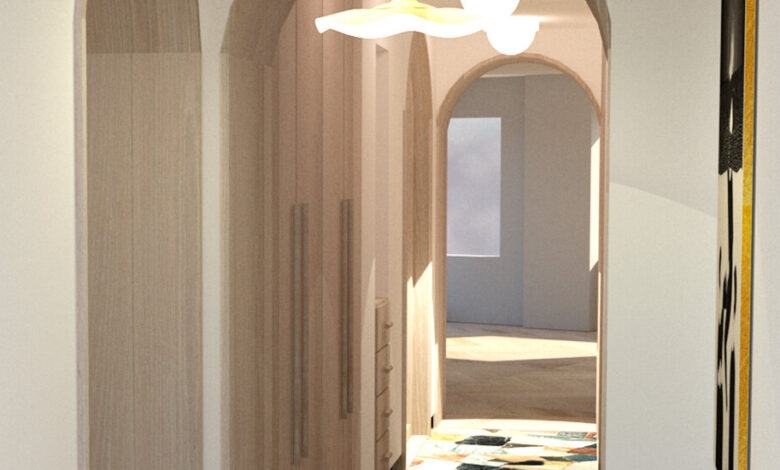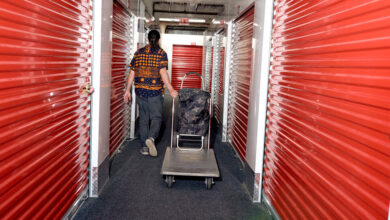The Return of the Foyer

[ad_1]
As the pandemic has changed the way many of us live in our homes, prospective buyers have become increasingly interested in a dedicated area near the front door for dumping masks, coats, shoes and boots, and for setting down packages and quarantining groceries — in other words, for just shaking off the outside world.
In response, some developers and builders are rethinking or revising their floor plans in order to incorporate a foyer.
“Pre-Covid, buyers wanted the feeling of big open spaces, big open kitchen, open living room,” said Matthew Muller, the director of construction and a principal at Glacier Equities, which does large-scale residential renovation projects around the city, primarily in the Bronx and Queens. “I always thought of it as the type of floor plan where you walk into the kitchen, throw your keys on the counter, take off your jacket and shoes and go about your evening.”
But now, Mr. Muller continued, “the idea of coming in from the subway or getting out of an Uber and throwing your keys on the kitchen counter just doesn’t sound right anymore.” Buyers have made their priorities known and that “has caused us to make design shifts and architectural changes midstream,” he said.
Pre-pandemic, Glacier would often move the front closet from its traditional spot, generally perpendicular to the front door, and instead make it parallel to the front door. Such was the preference of its clientele, because then “the closet door wasn’t the first thing they were seeing, and the line to the rest of the apartment was enhanced,” Mr. Muller said.
Now, when possible, he said, his construction crews relocate the front closet a few feet down the hall from the front door and hold with the perpendicular orientation. They also install a ceiling light fixture and put in flooring that’s different from the hardwood that paves that rest of the apartment, perhaps tile or stone, “to create a sense of separation,” Mr. Muller said. “It’s an airlock between the hallway and the rest of the house.”
At 450 Warren, a condo in Gowanus Brooklyn scheduled for completion this summer, each of the 18 units has a small parcel of covered outdoor space with a built-in bench just outside the front door.
“This was before Covid and we were sort of dipping our toe into the idea of a foyer,” said Sebastian Mendez, a co-founder of Tankhouse, the design-development firm behind 450 Warren.
Covid had just hit as Tankhouse was completing the purchase of its next property, 219 Jay Street, a 13-story condo project in Downtown Brooklyn that is slated to break ground later this year.
“As we were designing the new building we had to decide if we were going to continue to explore the foyer idea,” Mr. Mendez said. “The pandemic made us think that not only were we moving in the right direction but that we had to increase its size to the maximum and make it a key piece of the project.” Each of the development’s 27 units will have a foyer, in this case an angular covered outdoor space ranging in size from 100 to 200 square feet that will be outfitted with a bench and can double as a patio.
Admittedly, for some in the business, foyer is just another word for wasted space. “Developers tell architects to use every square inch as efficiently as possible, to pack in as much as possible, and in so doing the architect minimizes or deletes the foyer,” said Whitney Kraus, the director of architecture and planning for Brown Harris Stevens Development Marketing, which offers services like site analysis and market research for residential developments. “But because of everybody’s experience in the last year, we feel strongly that having a transition zone where you can take off your shoes and drop your packages is very important to buyers.”
Developers and design teams have responded accordingly “because they’ve experienced the pandemic along with everyone else,” Ms. Kraus said. Brown Harris Stevens Development Marketing, she said, is advising the developers of condos on the Upper East Side, in Gramercy and on the Upper West Side “to make sure that each apartment has a defined foyer.”
Once a building is under construction, developers are pretty well locked into a floor plan. But if a foyer wasn’t part of the concept at the beginning, design elements can be a corrective. “Since Covid, people are looking to separate the ‘dropping-off area’ from the main part of their home,” said Manuella Moreira, an interior designer based in Danbury, Conn.
The World’s Tallest Buildings
Learn More About N.Y.C. Skyscrapers
Ms. Moreira has been working with a couple who bought a three-bedroom condo in TriBeCa in the early days of the pandemic. The elevator opens straight into the apartment’s long hallway; the coat closet is far down that corridor into the apartment proper, across from the dining area. “That might not have been an issue before Covid but now it is,” Ms. Moreira said. “My clients don’t want to keep any outdoor items near where they eat or in the main area of the apartment so we’re moving the coat closet closer to the entry way.”
In order to make the hallway seem more a foyer than a mere pass-through, Ms. Moreira is adding wallpaper, wall mirrors and is changing the light fixtures.
“With Covid it’s really a safety precaution to have a foyer,” said Corey Kingston, the owner of Le Whit, a design studio with offices in New York and Seattle. When a couple recently bought two apartments in a building on the High Line, Ms. Kingston was charged with carving out a foyer.
She is doing so using the piece of common hallway that her clients had purchased to connect the units. “We’ll be tiling the floor and leaving the space bare so it can hold grocery or restaurant deliveries, a decision that was made largely because of Covid,” Ms. Kingston said.
“Before the pandemic no one imagined they’d be leaving their groceries untouched for hours and applying all this protective material,” she added. “Creating an area where all that can occur has become very important.”
It’s a balancing act, said Mr. Muller, of Glacier Equities. “At the end of the day, even during Covid this is still New York City and people have 700 to 800 square feet with Mom and Dad and two kids,” he said. “You have to figure out how to create that transition zone without taking away space from the rest of the apartment.”
For weekly email updates on residential real estate news, sign up here. Follow us on Twitter: @nytrealestate.
[ad_2]
Source link






